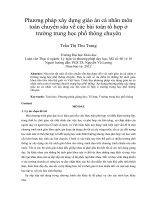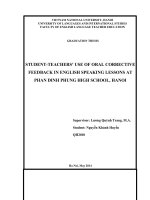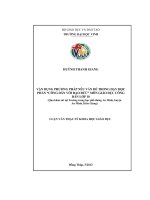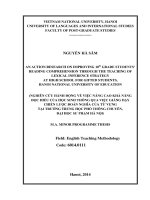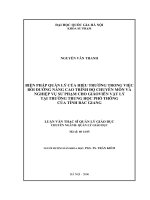VIỆC SỬ DỤNG NHỮNG NHẬN XÉT PHẢN HỒI KHẮC PHỤC THÔNG QUA LỜI NÓI CỦA CÁC GIÁO SINH TRONG CÁC GIỜ NÓI TIẾNG ANH TẠI TRƯỜNG TRUNG HỌC PHỔ THÔNG PHAN ĐÌNH PHÙNG, HÀ NỘI
Bạn đang xem bản rút gọn của tài liệu. Xem và tải ngay bản đầy đủ của tài liệu tại đây (509.26 KB, 104 trang )
VIETNAM NATIONAL UNIVERSITY, HANOI
UNIVERSITY OF LANGUAGES AND INTERNATIONAL STUDIES
FACULTY OF ENGLISH LANGUAGE TEACHER EDUCATION
GRADUATION THESIS
STUDENT-TEACHERS’ USE OF ORAL CORRECTIVE
FEEDBACK IN ENGLISH SPEAKING LESSONS AT
PHAN DINH PHUNG HIGH SCHOOL, HANOI
Supervisor: Lương Quỳnh Trang, M.A.
Student: Nguyễn Khánh Huyền
QH2010
Ha Noi, May 2014
ĐẠI HỌC QUỐC GIA HÀ NỘI
TRƯỜNG ĐẠI HỌC NGOẠI NGỮ
KHOA SƯ PHẠM TIẾNG ANH
KHOÁ LUẬN TỐT NGHIỆP
VIỆC SỬ DỤNG NHỮNG NHẬN XÉT PHẢN HỒI KHẮC
PHỤC THÔNG QUA LỜI NÓI CỦA CÁC GIÁO SINH TRONG
CÁC GIỜ NÓI TIẾNG ANH TẠI TRƯỜNG TRUNG HỌC PHỔ
THÔNG PHAN ĐÌNH PHÙNG, HÀ NỘI
Giáo viên hướng dẫn: Thạc sĩ Lương Quỳnh Trang
Sinh viên: Nguyễn Khánh Huyền
Khoá: QH2010
HÀ NỘI – NĂM 2014
ACCEPTANCE
I hereby state that I, Nguyễn Khánh Huyền, class: QH2010.F.1.E4, being a
candidate for the degree of Bachelor of Arts (TEFL) accept the requirements of the
University relating to the retention and use of Bachelor’s Graduation Paper deposited
in the library.
In terms of these conditions, I agree that the origin of my paper deposited in the
library should be accessible for the purposes of study and research, in accordance with
the normal conditions established by the librarian for the care, loan or reproduction of
the paper.
Signature
Nguyễn Khánh Huyền
Hanoi, May 5
th
, 2014
ACKNOWLEGMENT
First and foremost, I would like to express my gratitude towards my
supervisor, Ms. Lương Quỳnh Trang, for her valuable guidance and advice. She
has inspired me greatly to conduct this research. I also would like to thank her
for providing such a nice support, constructive feedback, and suggested sources
of useful materials.
Secondly, I give my thanks to Ms. Đoàn Thị Thu Trang for her detailed
comments for my research proposal and Mr. Lục Đình Quang for his helpful
suggestions for the first three chapters of this study.
Thirdly, I wish to express my sincere thanks to 25 student- teachers and
235 beloved students in seven classes including 10D1, 10D2, 10D5, 10Q1,
11D3, 12A2 and 12A3 at Phan Đình Phùng high school, who spent time
completing my questionnaire in detail. I would like to give special thanks to six
student- teachers who were willing to attend my stimulated recall interviews.
Appreciation is also expressed to five main English teachers in seven
classes at Phan Đình Phùng high school who allowed me to conduct classroom
observations and some other teachers who created chances for me to distribute
the questionnaires to the students.
Lastly, I heartily thank my family members, especially my mother, for
their encouragement that has helped me complete my thesis.
ABSTRACT
Over the last few years, corrective feedback, which is an indispensable
part in foreign language teaching, has become a highly controversial issue.
Many empirical studies in many countries have explored the impact of
corrective feedback on second language acquisition.
4
Nevertheless, not many topics relating corrective feedback have been
studied in Vietnam. In addition, few studies provided the real situation in using
oral corrective feedback of student- teachers, who are teaching under the
supervision of a certified teacher in order to qualify for a degree in education,
in schools during practicum time. Thus, this study investigated the use of oral
corrective feedback of student- teachers in English Speaking lessons at Phan
Đình Phùng high school, which hopes to fill the gap. The central aims of the
current study are to find out the types of corrective feedback used by the
student- teachers, factors influencing their choice for different types of
corrective feedback, types of corrective feedback leading to most uptake and
repair for students and students’ preferences for different types of corrective
feedback.
To collect sufficient reliable and valid data for the study, questionnaires,
stimulated recall interviews and observations were employed. 235 students and
25 student- teachers were invited to answer the survey questionnaires. The
researcher observed seven speaking periods of seven classes and conducted six
stimulated recall interviews with six student- teachers.
The study found out that the student- teachers used all six types of
corrective feedback, among which they opted for repetition, recast, and explicit
correction feedback type the most. The results of data analysis also revealed
that the students’ error types, one of the internal factors, and time pressure, one
of the external factors, guided the student- teachers’ choice for different types
of corrective feedback the most. Besides, other factors both external and
internal such as students’ learning style, student’ inattention or the student-
teachers’ desire also have some effect on the student-teacher’s choice of
feedback type. Regarding the types of corrective feedback leading to most
uptake and repair for students, data from classroom observations and
questionnaires for the student-teachers showed that explicit correction,
repetition and recast were the three most efficient types. Repetition, explicit
correction, and elicitation were three most effective types according to
5
students’ evaluation. Finally, most students preferred to receive explicit
correction and repetition.
TABLE OF CONTENTS
TABLE OF CONTENTS PAGE
Acknowledgements
Abstract
List of figures, tables and abbreviations
i
ii-iii
vii-viii
6
CHAPTER 1: INTRODUCTION
1.1 Statement of the problem and rationale for the study
1.2 Aims and research questions of the study
1.3 Scope of the study
1.4 Methods of the study
1.4.1 Data collection methods
1.4.2 Data analysis methods
1.5 Significance of the study
1.6 Organization of the study
1-2
2-3
3
3
3-4
4-5
5
5
CHAPTER 2: LITERATURE REVIEW
2.1 Key concepts
2.1.1 Corrective feedback
2.1.1.1 Definition
2.1.1.2 Types of corrective feedback
2.1.1.3 Factors influencing teachers’ choice for different
types of corrective feedback
2.1.2 Students’ uptake
2.1.2.1 Definition of uptake
2.1.2.2 Types of student uptake
2.2. Overview of related studies
6
6
6
6-9
9-10
10
10
10-12
12-14
7
CHAPTER 3: METHODOLOGY
3.1. The setting of the study
3.2. Description of samples and sampling methods
3.3 Data collection instruments
3.3.1 Survey questionnaire
3.3.2 Classroom observation
3.3.3 Stimulated Recall
3.4 Data collection procedures
3.4.1 Survey questionnaire
3.4.2 Classroom observation
3.4.3 Stimulated Recall
3.5. Data analysis procedures
3.5.1 Survey questionnaire
3.5.2 Classroom observation
3.5.3 Stimulated recall
15
15-16
16
16-17
17-18
18
18
18-19
19
19-20
20
20-21
21
21
CHAPTER 4: FINDINGS AND DISCUSSION
4.1. Research question 1: What types of corrective feedback used
by the student- teachers in speaking lessons?
4.2. Research question 2: Which factors guide the student-teachers’
choice for different types of corrective feedback in Speaking
lessons?
4.2.1 Survey questionnaire
4.2.2 Stimulated recalls
4.3 Research question 3: Which types of corrective feedback do the
students and student-teachers think lead to most uptake and
repair?
4.3.1 Students’ opinions
4.3.2 Student- teachers’ opinions
4.3.3 Class observation
4.4 Research question 4: Which types of feedback do the students
prefer to get?
22-25
25
25-26
26-32
32
32-34
34-36
36-38
38-43
CHAPTER 5: CONCLUSION
5.1 Summary of findings
5.2 Pedagogical implications
44-45
45-46
8
5.3 Limitations of the study
5.4 Suggestions for further research
46-47
47-48
REFERENCES
49-51
APPENDICES
APPENDIX 1: Survey questionnaire for student-teachers
APPENDIX 2 : Survey questionnaire for students
APPENDIX 3: Stimulated recall questions
APPENDIX 4: Stimulated recall coding
APPENDIX 5: Stimulated recall interviews transcript
APPENDIX 6: Observation schemes
I-V
VI-XII
XIII
XIV- XX
XXI- XXIX
XXX- XLVII
LIST OF TABLES, FIGURES AND ABBREVATIONS
LIST OF TABLES PAGE
Table 1
Observation scheme
17
Table 2
Distribution of uptake and repair in relation to corrective
feedback types
36
Table 3
Mean of students’ preferences
38-40
LIST OF FIGURES
Figure 1
Distribution of types of corrective feedback (according to
survey questionnaire for the student-teachers)
23
Figure 2
Distribution of types of corrective feedback (according to
survey questionnaires for students)
24
Figure 3
Distribution of factors guiding the teacher- trainees'
choice for different types of corrective feedback
25
Figure 4
Distribution of the effectiveness of types of corrective
feedback (according to the students)
33
Figure 5
Distribution of the effectiveness of types of corrective
feedback (according to the student- teachers)
35
9
LIST OF ABBREVATIONS
FELTE: Faculty of English Language Teacher Education
ULIS: University of Languages and International Studies
VNU: Vietnam National University
PDP: Phan Đình Phùng
ELT: English Language Teaching
ESL: English as a Second Language
EFL: English as a Foreign Language
10
CHAPTER 1: INTRODUCTION
This chapter presents the research problem and rationale for the study
along with its aims, methodology, scope and significance. The four research
questions are particularly identified in this chapter to guide the whole
research. Finally, the organization of the paper is shown to direct the audience
through the paper.
1.1 Statement of the problem and rationale for the study
There has been an increasing interest in researching corrective feedback
in second language learning in recent years. It can be seen that learners’ errors
play significant roles in the studying process for three different reasons. First to
the teacher, learner errors show him or her “how far towards the goal the
learner has progressed and, consequently, what remains for him to learn”
(Corder, 1967, p.25).Secondly, a learner’s errors provide the researcher with
evidence of the way of the language being learned. Thirdly, errors are
inevitable to the learners themselves. Errors are made, which helps learners
study more. It is also the way for learners to test their “hypotheses about the
nature of the language they are learning” (Corder, 1967, p.25). Moreover,
feedback on those errors is very important and necessary, especially during the
course of communication activities (Ellis, 1994).
Researchers have shown that teachers’ corrective feedback enables
students to notice the gap between their interlanguage and the target language.
Additionally, teachers’ corrective feedback also directs to the improvement of
learners’ metalinguistic awareness (Swain, 1995). Therefore, teachers’
corrective feedback promotes students’ repairs and enhances their motivation.
For most students in high schools, speaking skill may be considered one
of the most challenging ones. When students speak English, they can make
various errors, and if these errors are not corrected, students will mistake them
11
for the correct form. Hence, the oral English will be easy to fossilize if teachers
do not provide corrective feedback.
Nevertheless, the issue of corrective feedback is still a sophisticated one.
Whereas some language acquisition theories and second language teaching
methodologies question the use of corrective feedback, there are others which
favor its use and see it as beneficial. “Teachers of foreign languages, however,
sometimes are unaware of these issues and their view towards corrective
feedback and, consequently, their practice in the classroom can be affected”
(Mendez, Argulles, Castro,& Roo, 2010, p.255). Moreover, some students
expect the teacher to give them feedback on their performance (Harmer, 2001).
The field of corrective feedback has been widely researched; however,
not many studies in the world and in Vietnam have been done concerning the
factors influencing teachers’ choice for different types of corrective feedback.
Besides, student- teachers, often used interchangeably with teacher-trainees,
trainee- teachers or pre-service teachers, and students in high schools seem to
receive less consideration in previous studies. Therefore, the researcher chose
the student- teachers from FELTE, ULIS, VNU and students at PDP high
school in Hanoi to be the research population. It can be seen that the student-
teachers have less teaching experience than the main teachers and their
employment of different corrective feedback types may be different. It is noted
that most teacher- trainees will become main teachers in the near future.
Therefore, the ways they give corrective feedback to students should be taken
into consideration.
All those reasons have inspired the researcher to conduct a study on the
student-teachers’ use of oral corrective feedback in Speaking lessons at PDP
high school in the hope that it will help fill the gaps in the literature.
1.2 Aims and research questions of the study
The overall aim of the study was to investigate how the student-teachers
employed corrective feedback in speaking lessons during their teaching
practice at PDP high school. Specifically, the aims of the study are as follows:
12
• To identify the types of corrective feedback used by the student- teachers in
speaking lessons;
• To investigate factors which guide the teacher- trainees’ choice for different
types of corrective feedback in speaking lessons;
• To identify the types of corrective feedback which lead to most uptake and
repair for students; and
• To explore the students’ preferences for the types of student-teachers’
corrective feedback.
In particular, the research paper seeks the answers to the following
research questions:
1. What types of corrective feedback used by the student- teachers in speaking
lessons at PDP high school?
2. Which factors guide the student- teachers’ choice for different types of
corrective feedback?
3. Which types of corrective feedback do the students and student-teachers
think lead to most uptake and repair?
4. Which types of corrective feedback do the students prefer to get?
1.3 Scope of the study
The study focused on the teacher- trainees’ use of oral corrective
feedback on students’ spoken errors in English speaking lessons for 10
th
graders, 11
th
graders and 12
th
graders at PDP high school in Hanoi. Participants
of the study were the student-teachers from FELTE, ULIS, VNU who
conducted their 6-week practicum at PDP high school and 10
th
graders, 11
th
graders and 12
th
graders at this school. The researcher chose this research site
because she was one of these student-teachers, so it was easier for her to access
the research site and prospective participants.
1.4 Methods of the study
1.4.1 Data collection methods
The researcher made use of both quantitative (survey questionnaires)
and qualitative (classroom observations and stimulated recalls) methods to
obtain data for the study. First of all, questionnaires were distributed to 25
teacher- trainees at PDP high school and students in the observed classes to
13
explore the current situation. Specifically, the questionnaire helped the
researcher to find out the types of corrective feedback used by the student-
teachers. In addition, the questionnaire was chosen to investigate the student-
teachers’ and students’ evaluation of the effectiveness of different types of
corrective feedback and students’ preferences for the pre-service teachers’
corrective feedback. Besides, the researcher conducted classroom observations
in seven classes to seek information about the types of oral corrective feedback
used as well as and their effects on the students’ uptake and repair. In addition,
stimulated recall was used to find out the factors influencing the pre-service
teachers’ choice of corrective feedback. The teacher- trainees in the classes
where the researcher conducted classroom observations were the participants.
1.4.2 Data analysis methods
The general approach for data analysis was content analysis (Grbich,
2007). Relevant sections to the research questions were identified or underlined
while each piece of data was evaluated. The contents were then categorized
based on the four research questions.
Particularly, the first question was answered by data gathered from the
survey questionnaires for both the student- teachers and students. The second
question was investigated by data collected from the stimulated recalls and
questionnaires distributed to the teacher- trainees. The third question was found
out by analysing the data from the survey questionnaires for the student-
teachers and students as well as the classroom observations. Data from the
questionnaires for the students answered the last question.
To visualise the results, percentage and frequency counts were
calculated and presented in tables and charts. Besides, ideas from stimulated
recall method were coded and highlighted for later use.
1.5 Significance of the study
The study is conducted to find out the oral feedback used by the student-
teachers, the factors guiding their choices of feedback types, the effects of
those types on the students’ uptake and repair and the students’ preferences.
14
Once completed, the study is expected to provide English pre- service teachers
a number of significant pedagogical implications in terms of using corrective
feedback. Moreover, it would point to them which types of corrective feedback
to use in order to lead to the greatest amount of student uptake and repair. This
study may serve as a good reference for ELT lecturers when they train the
future teachers to exploit oral feedback in speaking lessons. Lastly, this study is
hoped to provide useful information for other researchers who want to
investigate this issue in the future.
1.6 Organization of the study
Beside chapter 1, the Introduction, the rest of paper includes the four
following chapters:
Chapter 2 (Literature Review) provides the background of the study
including definitions of key concepts and discussions of related studies.
Chapter 3 (Methodology) describes the setting of the study, participants,
data collection and data analysis methods and procedures.
Chapter 4 (Results and Discussion) presents, analyzes and discusses the
findings based on the gathered data.
Chapter 5 (Conclusion) summarises the main ideas, provides some
pedagogical implications and points out the limitations of the research as well
as shows some suggestions for further studies. Following this chapter are the
References and Appendices.
CHAPTER 2: LITERATURE REVIEW
This chapter presents the two key concepts that form the theoretical
background of the study including ‘oral corrective feedback’ and ‘students’
uptake’. Finally, some related studies will be reviewed to show the gap and lay
the foundation for this study.
2.1 Key concepts
2.1.1. Oral corrective feedback
2.1.1.1 Definition
15
It is important to define what the teachers’ oral corrective feedback is.
The term oral corrective feedback has been defined at different times in a very
similar way. Chaudron (1977) has defined the teacher oral corrective feedback
as “any reaction of the teacher which clearly transforms, disapprovingly refers
to, or demands improvement of the learner utterance” (as cited in Panova and
Lyster, 2002, p. 574). Schachter (1991) has stated that corrective feedback,
negative evidence, and negative feedback are three terms used individually in
the fields of language teaching, language acquisition, and cognitive
psychology. He has considered corrective feedback as teachers’ utterances that
point learners’ errors. Lyster and Ranta (1997) have considered oral corrective
feedback as the ‘strategies’ teachers use to correct students’ errors and classify
corrective feedback into two major types: implicit feedback and explicit
feedback. Having the same view with Lyster and Ranta (1997), Lightbown and
Spada (1999) have defined corrective feedback as “Any indication to the
learners that their use of the target language is incorrect. This includes
various responses that the learners receive” (p. 171).
In this paper, the teacher oral corrective feedback refers to the teacher
correction of and indication to learners’ errors.
2.1.1.2 Types of corrective feedback
A lot of researchers in the field of English teaching have classified
corrective feedback into implicit or explicit one. Lightbown and Spada (1999),
for example, have stated that:
When a language learner says, ‘He go to school every day’, corrective
feedback can be explicit, for example, ‘no, you should say goes, not go’
or implicit ‘yes he goes to school every day’, and may or may not include
metalinguistic information, for example, ‘Don’t forget to make the verb
agree with the subject (pp. 171-172)
More recently, Fawbush (2010) has emphasized that “Of the various
types of corrective feedback, each can be placed under the category of implicit
or explicit.” Explicit feedback means feedback which points out an error
16
having occurred within an utterance (Fawbush, 2010, p. 16). However, implicit
feedback allows the teacher to give the correct form out loud (Fawbush, 2010,
p. 16) like the example given by Lightbown and Spada (1999) above.
Lyster and Ranta (1997) in their work have agreed that corrective
feedback can be either implicit or explicit. They have also further identified the
sub-categories. Specifically, they have classified corrective feedback into six
categories, including: explicit correction, recast, metalinguistic feedback,
elicitation, repetition, and clarification request. Among these types of corrective
feedback, explicit correction and metalinguistic feedback are considered as the
explicit ones whereas recast and clarification request are among the implicit
types of corrective feedback. These types of corrective feedback are presented
in detail as follows:
• Explicit correction: “Explicit correction refers to the explicit provision of
the correct form. As the teacher provides the correct form, he or she clearly
indicates that what the student had said was incorrect” (Lyster & Ranta,
1997, p.46).
For instance:
S: She has cat.
T: not has cat. Has a cat.
• Recasts: The teacher does not indicate directly that the student made an
error, but implicitly reformulates the student’s error or provides the
correction (Lyster & Ranta, 1997, p.46).
For example:
S: She has cat.
T: She has a cat.
S: Yes, she has a cat.
• Clarification requests: The teacher indicates to the student that the utterance
is not correct in some way and that the student needs to repeat or
reformulate the utterance. A clarification request includes some phrases
such as "Excuse me?", “Pardon me?” or "I don't understand”. It may also
17
include a repetition of the error such as “What do you mean by X?”(Lyster
& Ranta, 1997, p.47).
For instance:
S: She has cat and feed it every day.
T: Pardon me?
S: She has a cat and feeds it every day.
• Metalinguistic feedback: The teacher asks questions, provides comments or
gives information related to the formation of the student's utterance without
providing the correct form (Lyster & Ranta, 1997, p.47).
For example:
S: She has a cat and feed it every day.
T: Use the simple present consistently.
S: She has a cat and feeds it every day.
• Elicitation: Elicitation refers to some techniques that teachers employ to
directly elicit the correct form from the student.Firstly, teachers can elicit
completion of their own utterance by strategically pausing to allow students
to “fill in the blank”. Secondly, they can use questions such as “How do we
say X in English?” to elicit correct forms. Thirdly, they can directly ask
students to reformulate their utterance (Lyster & Ranta, 1997, p.48).
For instance:
S: She has a cat and feed it every day.
T: She has a cat and…
S: and feeds it every day.
• Repetition: Teachers repeat the student’s incorrect utterance in isolation. In
most cases, they change their intonation to highlight the error (Lyster &
Ranta, 1997, p.48).
For example:
S: She feed her cat every day.
T: She feed her cat every day? (question mark in the teacher voice)
18
S: She feeds her cat every day
The study has followed the classification of corrective feedback
proposed by Lyster and Ranta (1997) because it has been considered the most
comprehensive taxonomy of corrective feedback so far (Li, 2010; Taipale,
2012).
2.1.1.3 Factors influencing teachers’ choice for different types of
corrective feedback
Some researchers have identified the factors affecting teachers’ choice
for different feedback types.
Menti (2006) has stated that teachers opt for recasts because they want
to provide the correct from directly to avoid students’ embarrassment or
demand. How much and what kind of assistance the teacher feels that the
student needs at the moment of the corrective intervention are the factors
influencing the teacher’ s use of recasts. Also, he has showed that the reasons
teachers use elicitation feedback are mostly related to “teachers’ certainty that
the student being corrected has the linguistic and emotional conditions to
reformulate his/her utterance” (Menti, 2006, p.726). Besides, the
metalinguistic feedback is also a choice of teachers in his study; the teachers
choose this kind due to “how much and what kind of assistance the teacher
feels the student needs, and to the appropriate time to help the learner”
(Menti, 2006, p.726). When choosing this kind, like when choosing recasts and
elicitation, teachers base on the sociocultural concepts of assistance (Menti,
2006, p.726).
Gurzynski-Weiss in 2010 carried out a study which investigated the
factors influencing oral corrective feedback provision in the Spanish foreign
language classroom by native and nonnative teachers with different teaching
experiences. The study has shown that many internal and external factors were
involved in the ways the teachers did or did not correct their students during
class time. Internal factors included learner affective factors, prior knowledge,
etc. (Gurzynski-Weiss, 2010, p.177). External factors comprised timing in the
19
class, number of turns already taken, linguistic target of lesson, course goals,
and so on (Gurzynski-Weiss, 2010, p.177 ). Also, there were differences
according to individual variables, and “teachers reported more external than
internal factors, and the fewest factors reported overall were by the more
experienced instructors” (Gurzynski-Weiss, 2010, p.199).
2.1.2 Students’ uptake
2.1.2.1 Definition of uptake
Learner uptake is related to the notions of attention (Logan, 1988).
Logan (1998, p.511) stated that “attention to a stimulus is sufficient to cause
the retrieval of all of the information associated with the stimulus”. It may be
shown that uptake is one way of identifying which items students have attended
to in the preceding corrective feedback.
According to Lyster and Randa (1997, p.49) uptake is defined as “a
student’s utterance that immediately follows the teacher’s feedback and that
constitutes a reaction in some way to the teacher’s intention to draw attention
to some aspect of the student’s initial utterance”.
2.1.2.2 Types of student uptake
Quite a few researchers in the field of language teaching have agreed
that the types of student uptake proposed by Lyster and Ranta (1997) has by far
the most significant and comprehensive (Panova and Lyster, 2002; Suzuki,
2005). According to Lyster and Ranta (1997), there are two types of student
uptake: repair and needs- repair.
• Repair
Lyster and Ranta (1997, p.49) has defined repair as “the correct
reformulation of an error as uttered in a single student turn and not to the
sequence of turns resulting in the correct reformulation; nor does it refer to
self-initiated repair”. Unprompted self-corrections were not analyzed. Instead,
they “analyzed repairs occurring only after prompting—what Schegloff,
Jefferson, and Sacks (1977) have called “other-initiated repair” (Lyster &
Ranta, 1997, p.49)
20
There are four types of other-initiated repair in Lyster and Ranta’s (1997)
study:
Repetition refers to a student’s repetition of the teacher’s feedback when
the latter includes the correct form.
Incorporation refers to a student’s repetition of the correct form provided
by the teacher, which is then incorporated into a longer utterance produced
by the student.”
Self-repair refers to a self-correction, produced by the student who made
the initial error, in response to the teacher’s feedback when the latter does
not already provide the correct form.
Peer-repair refers to peer-correction provided by a student, other than the
one who made the initial error, in response to the teacher’s feedback.(p.
50)
• Needs- repair
“Needs-repair” includes six types of utterances as follows:
Acknowledgment generally refers to a simple “yes” on the part of the
student in response to the teacher’s feedback, as if to say, “Yes, that is
indeed what I meant to say (but you’ve just said it much better!”) (see
Calve´ , 1992). Acknowledgment may also include a “yes” or “no” on the
part of the student in response to the teacher’s metalinguistic feedback.
Same error refers to uptake that includes a repetition of the student’s initial
error.
Different error refers to a student’s uptake that is in response to the
teacher’s feedback but that neither corrects nor repeats the initial error;
instead, a different error is made.
Off target refers to uptake that is clearly in response to the teacher’s
feedback turn but that circumvents the teacher’s linguistic focus altogether,
without including
any further errors.
Hesitation refers to a student’s hesitation in response to the teacher’s
feedback.
Partial repair refers to uptake that includes a correction of only part of the
initial error.” (Lyster & Ranta, 1997, pp.50-51)
2.2. Overview of related studies
Corrective feedback and student uptake have stimulated interest among
researchers for many years.
Firstly, Chaudron (1997) (as cited in Russel & Spanda, 2006)
investigated the different types of corrective feedback provided to French
immersion students. He mentioned that lots of teachers’ feedback went
unnoticed. Some types of corrective feedback like repetition with emphasis led
21
to more immediate students’ reformulations than others (e.g. repetition without
emphasis).
In addition, Doughty (1994) (as cited in Russel & Spanda, 2006), who
studied corrective feedback given to learners of French as a foreign language,
pointed that the most frequently used types of corrective feedback were
clarification requests, repetition and recasts. Learners responded most
frequently to recasts.
Another study by Lyster and Ranta’s (1997) investigated different types
of corrective feedback comprising explicit correction, recasts, clarification
requests, metalinguistic feedback, elicitation, and repetition. The study showed
that the most frequently used feedback type was the recast. The recast
accounted for just over half (55%); however, it is the least likely to lead to
uptake of any kind: only 31% of the recast moves lead to learner uptake.
Instead, other types of corrective feedback received more responses from
learners. The most successful technique for eliciting uptake is elicitation.
Other studies such as Panova and Lyster (2002) and Lochtman (2000)
(as cited in Russel & Spanda, 2006) also showed the same result with the
above study in regard to the most frequently used type of corrective feedback
being recasts. Sheen (2004) also explored corrective feedback, learner uptake
and repair, and the relationship between various feedback and learner uptake at
different instructional settings. Similar to above studies, this study’s final
results showed that recasts were the most frequently used feedback type.
Comparing across four different settings, in terms of learners’ uptake to recasts,
Canada immersion made the least uptake; however, the Korean setting made
the most uptake (70%).
In terms of factors guiding teachers’ choice for types of corrective
feedback, Menti (2006, p. 727) concluded that “although the five teachers
studied have different experiences, length of teaching practice and
educational background, they consider mainly the following factors when they
decide to opt for types of feedback: how they think the student is feeling at the
22
moment, how they consider the personality of the student, and how they
judge the linguistic knowledge and emotional capacity of the student.”
Besides, in the study by Gurzynski- Weiss (2010), many internal factors, such
as learner affective factors and prior knowledge, and external factors, such as
timing in the class, number of turns already taken and linguistic target of
lesson, led to different teacher choices for types of corrective feedback.
Regarding students’ preferences for types of corrective feedback,
Yoshida (2008)’s study showed that the students preferred receiving feedback
such as clarification or elicitation so as to self- correct their utterances than
receiving correct forms immediately.
In Vietnam, there have also been quite many studies researching this
issue. As Bui (2009) stated in her study entitled “Relationship between
teachers’ corrective feedback and students’ uptake and repair in first- year
English speaking lessons” that the most frequently used type of corrective
feedback was recast. However, it is evident that recast was not the most likely
to lead to uptake. This result is similar to the findings of some studies in the
world as mentioned above. In terms of students’ preferences for teachers’
corrective feedback, the study showed that almost all of the students wanted the
teachers to correct their errors in speaking lessons. And, they desired to be
given feedback immediately from the teachers during accuracy activities. In
addition, with lexical and grammatical errors, first year students favored
metalinguistic feedback type. Besides, they were interested in receiving explicit
correction feedback type in accordance with phonological errors.
However, not many studies in Vietnam have examined the aspects
guiding teachers’ choices for different types of corrective feedback and most
studies focus on the teachers and students at universities. Such limitations have
offered a gap for the researcher to conduct a study on a different target
population and attempt to examine the factors leading the student- teachers’
choices for types of corrective feedback and learners’ uptake and preferences in
a more comprehensive way.
23
Summary
So far in this chapter the two key concepts, i.e. teacher oral corrective
feedback and student uptake, have been presented in detail. In addition, the
review of some related studies has shown a research gap that the study can
help fill in.
CHAPTER 3: METHODOLOGY
In this chapter, the methodology used to find the answers to the research
questions will be described in detail. The research setting, participants, data
collection instruments as well as the procedure of data collection and analysis
will be explained.
3.1. The setting of the study
Phan Dinh Phung high school is a big school in the centre of Hanoi. The
researcher chose PDP high school as it was the one she did practicum in.
Hence, it is easier for her to get necessary data. For many years, the school has
24
hosted the fourth-year students from the FELTE, ULIS, VNU who come to
conduct their teaching practicum in the school for 6 weeks. For the academic
year 2013-2014, the practicum took place from 10
th
February to 22
nd
March,
2014. The student-teachers were assigned to teach students in 10
th
, 11
th
and 12
th
grade, using the standard English textbooks, i.e. Tieng Anh 10, Tieng Anh 11
and Tieng Anh 12. Because this study investigated the use of oral corrective
feedback by the student-teachers in the real classrooms, both the student-
teachers and students in their classes were invited to be the participants.
3.2. Description of samples and sampling methods
All the trainee-teachers from ULIS who did their teaching practice at
PDP high school were invited to answer the survey questionnaires. However,
due to the overlapping timetable and the researcher possible workload, only
seven of them were observed in seven speaking lessons. Before going to the
high school for their practicum, these students had completed four courses of
English Language Teaching Methodology. Particularly, in the second course
named ESL/EFL Classroom Techniques and Practices, they were provided with
classroom management skills and techniques to teach the four language skills
including how to give oral feedback to students. They also experienced Micro-
teaching sessions, in which they taught their classmates.
In addition, participants of the research were also all10
th
graders in four
classes including 10D1, 10D2, 10D5 and 10Q1, all 11
th
graders in class 11 D3,
and all 12
th
graders in two classes: 12A2 and 12A3. They were the students
who were taught by the seven teachers chosen to be observed in speaking
lessons above.
3.3 Data collection instruments
To collect valid and reliable data for the investigation, three data
collection instruments, i.e. survey questionnaire, classroom observation,and
stimulated recall, were employed.
3.3.1 Survey questionnaire
25


